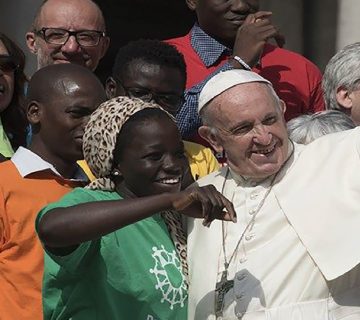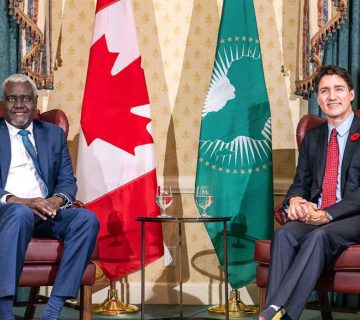The video appearance of the presumably dead Abu Bakr al-Baghdadi has sent signals that counter-terrorism agencies should contemplate carefully. The April 2019 video, a sequel to the June 2014 Great Mosque one in which the world’s most wanted man and self-proclaimed leader of the most active and deadliest terrorist organization in the world declared the establishment of the ‘Caliphate’ in Iraq and Syria, suggests that al-Baghdadi is alive. It also indicates his desire to be heard by both the world and the converted. Failure to receive these signals will erode gains made to curtail terrorism not only in the Middle East, but also in Africa.
In the 18-minute, yet-to-be-authenticated 2019 video titled ‘In the Hospitality of the Emir of the Believers,’ al-Baghdadi appears less bothered about the change of his status from Caliph (religious and political authority) to the most wanted man in the world, or that IS has morphed from a movement that controls territory to an insurgency without borders. He acknowledges the loss of physical territory in Iraq (Mosul) and Syria (Raqqa), noting that ‘the Caliphate’ has gone borderless. However, he downplays the impact this unexpected change from statecraft model of governance to governance through networks could have on his call, saying, “Allah the Almighty ordered us to commit jihad and did not order us to win.” Further, ‘the Caliphate’ still has dedicated “media soldiers” whom he has likened to mujahideen. In other words, fighting jihad is more important than winning against the ‘the enemy,’ and IS is still fighting using different kinds of mujahideen.
‘Borderless Caliphate’
On the shift to an insurgency without borders, al-Baghdadi gives the impression he is aware of the realities of a globalizing world where borderless entities – including virtual ones – could have similar or more power than bordered entities such as States. Besides, these entities cannot be attacked militarily. Advanced technologies have made it possible for virtual communities to exist and interact with each other, often without the influence of the State. This is perhaps why he also speaks about the power of the jihadi “media soldiers.”
The intense anti-IS military campaigns in Syria and Iraq, especially in 2017, degraded IS’s capacity to produce and disseminate its ideology through its endorsed ‘propaganda’ outlets as personnel and infrastructure were affected. For instance, Rumiya, a 13-language publication on ideological developments that started operations in 2016, stopped publishing in September 2017. Social media companies also disrupted their activity on several social media sites significantly, according to Europol.
That said, Europol has reported that there has been a slight increase in IS media production by IS-endorsed propaganda outlets such as al-Naba, A’maq, and al-Furqan since late last year. IS also explored alternative social media sites, including closed chat groups on Telegram. These realities indicate the limitations of ‘hard power’ approaches to countering terrorism, and suggest that IS “media soldiers” are still motivated to spread IS ideology and grow the IS brand in virtual or cyberspaces.
Territorial Wars
The said military campaigns also saw the displacement of experienced foreign fighters from Iraq and Syria to, among other locations, Yemen as well as different parts of Africa. IS fighters have been reported to be in Somalia, Sudan, DR Congo, and Libya. IS has established a chapter in Somalia, the Islamic State in Somalia (ISS) that has been based in Somalia for about four years now, according to the International Crisis Group (ICG). ISS launched attacks in Mogadishu in 2017 and 2018, challenging al Qaida’s franchise, al Shabab, in the process. Al Shabab has been in Somalia since 2006, and considers Somalia, including Somaliland its sphere of influence. The group launched the deadliest terrorist attack in Africa yet in Mogadishu in October 2017, killing more than 500 people, and injuring hundreds more. Al Shabab is more dominant in Somalia, compared to ISS, but the latter has a stronger appeal compared to al Shabab because of its association with IS.
It is not yet clear whether or for how long ISS will hold out in Somaliland, or if it will support other terrorist organizations in other countries in the region. It seems, based on al Shabab’s explanation of its attack at DusitD2 in January 2019 as fury over the relocation of US’s Embassy in Israel to Jerusalem that al Shabab is also seeking to project itself both as the leading terrorist organization in the region, and as a group with a global outlook. Possible rivalry between ISS and al Shabab in Somalia, coupled with the planned exit of AMISOM troops from Somalia next year (2020) could increase terrorism in Somalia. Al Shabab could increase its influence beyond Somalia and Kenya, to Tanzania, Mozambique, Uganda, and DR Congo where the group is reportedly establishing sleeper cells. ISS should not be overlooked though. The European Institute of Peace notes, “If ISS can establish itself as the main Islamic State group in the Horn of Africa, providing leadership to other Islamic State offshoots and establishing sustainable links to the Islamic State leadership, perhaps through Yemen, it could yet grow to become a real security challenge for as long as the Islamic State brand remains strong.” IS claimed the first ever terrorist attack in DR Congo in Kamango near the DR Congo-Uganda border on April 18, 2019. It should be noted that DR Congo’s most active insurgent group, Allied Democratic Forces (ADF), has been linked to al Qaida. The rivalry between IS and al Shabab in DR Congo is to be expected. Questions over the ‘leadership’ style of al-Baghdadi, a technocrat, and his ability to rally a meaningful following for sustained periods have been raised casting doubt on the longevity of IS.
Political Change
Somalia is not the only African country that should worry counter-terrorism agencies in the region. Sudan should too, and so should Algeria and Libya, because al-Baghdadi also singled out north Africa (MENA), alongside Mali and Burkina Faso as IS’s affiliate chapters. The leaders of Sudan and Algeria were recently ousted. Sudan’s former President, Omar al-Bashir, was prevailed upon, by military and security forces, and civilian pro-democracy protestors, to leave office on April 11, 2019. The people of Sudan want a civilian administration of their country, and have been protesting since 19 December 2018. In a manner similar to Sudan, Algeria’s former President, Abdelaziz Bouteflika, was forced to step down in April 2019 in response to growing and sustained calls, which started on February 22, for him to leave office. Abdelkader Bensalah, Head of the Upper House of Parliament, will be the interim president until July 4, when a presidential election will be held. Sudan borders Libya to the northwest, while Algeria borders Libya to the east. It is still not clear how the civilian-led revolutions in Sudan and Algeria will end. If a peaceful transition from military to civilian rule fails, IS may gain the support of armed groups on the fringes of the political system and the desert, but the impact on security may be minimal.
It should not be lost on counter-terrorism agents that IS has launched a global mission dubbed operation ‘revenge for al Sham.’ Al Sham, according to Lydia Wilson, an Oxford University researcher, could refer to either the Greater Syria or Levant, composed of Syria, Lebanon, parts of southern Turkey, Jordan, and Israel-Palestine, or the area covered by Syria and Iraq. It can be expected that IS sympathizers and mujahideen, including its “media soldiers,” will be involved in this revenge mission. It is also likely that some of the mujahideen will be drawn from Somalia, Sudan, DR Congo, Libya, and Algeria, as well as Mali and Burkina Faso.
Alternative Approaches
Al-Baghdadi’s message, which was meant for both real and virtual audiences, is likely to resonate with IS supporters and affiliated groups in the greater Horn of Africa. Counter-terrorism agencies should shift focus to the multilingual, ‘borderless Caliphate.’ This will mean, among other things, taking down terrorist online content in languages other than English, as this content is also available in Arabic, French, Indonesian, Kurdish, Pashto, and Urdu, among other languages. It will also mean complementing ‘hard power’ approaches which cannot eliminate radicalization into violent extremism with ‘soft power’ ones. Furthermore, there is a possibility that the withdrawal of AMISOM troops from Somalia next year could see al Shabab regain territory in Somalia, and an increased number of IS fighters leaving Syria and Iraq for Somalia. The potential of rivalries between IS and al Shabab playing out in Somalia could increase the incidence and prevalence of terrorism in Somalia, and the greater Horn of Africa region. ISS should not be given room to grow in Somalia or any other country in the region. It will be crucial for the international community, including security agencies, to consult widely and manage this process well, to safeguard gains made to counter terrorism, and maintain peace and security in the region. As conflict continues to bolster terrorism, efforts should also be made to reduce protracted conflicts and promote peace-building in affected countries in particular, and in the greater Horn of Africa in general.
Roselyne Omondi is the Associate Director, Research, at the HORN Institute.
Photo Credit: Getty Images



